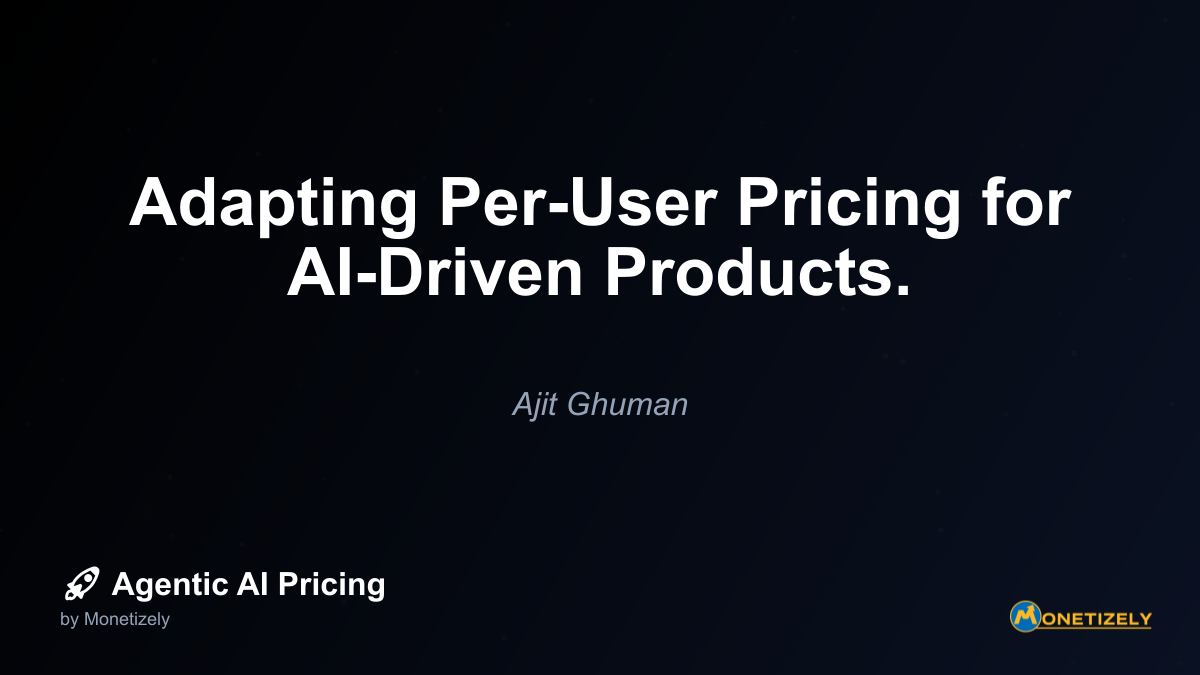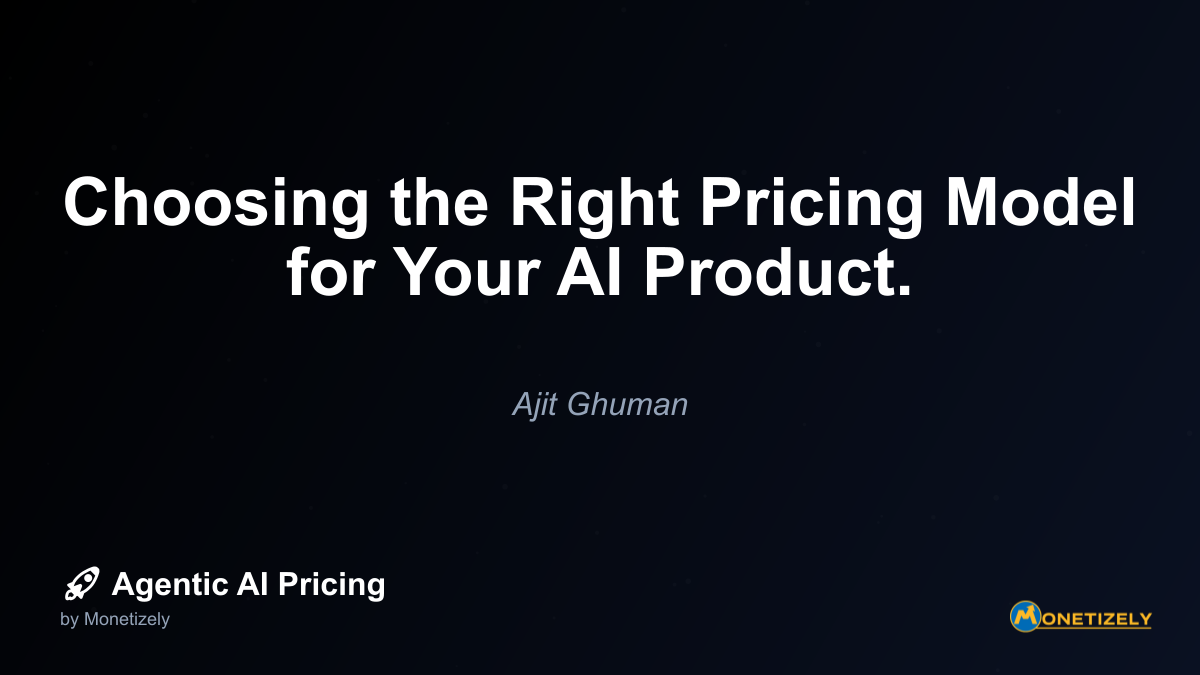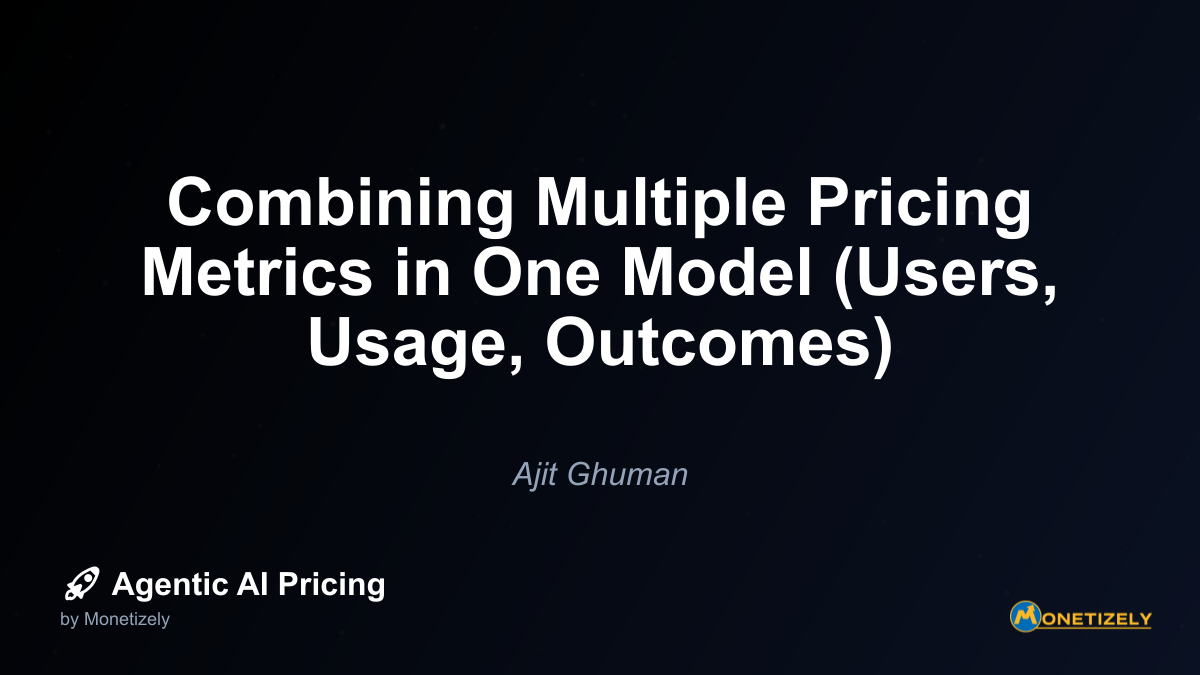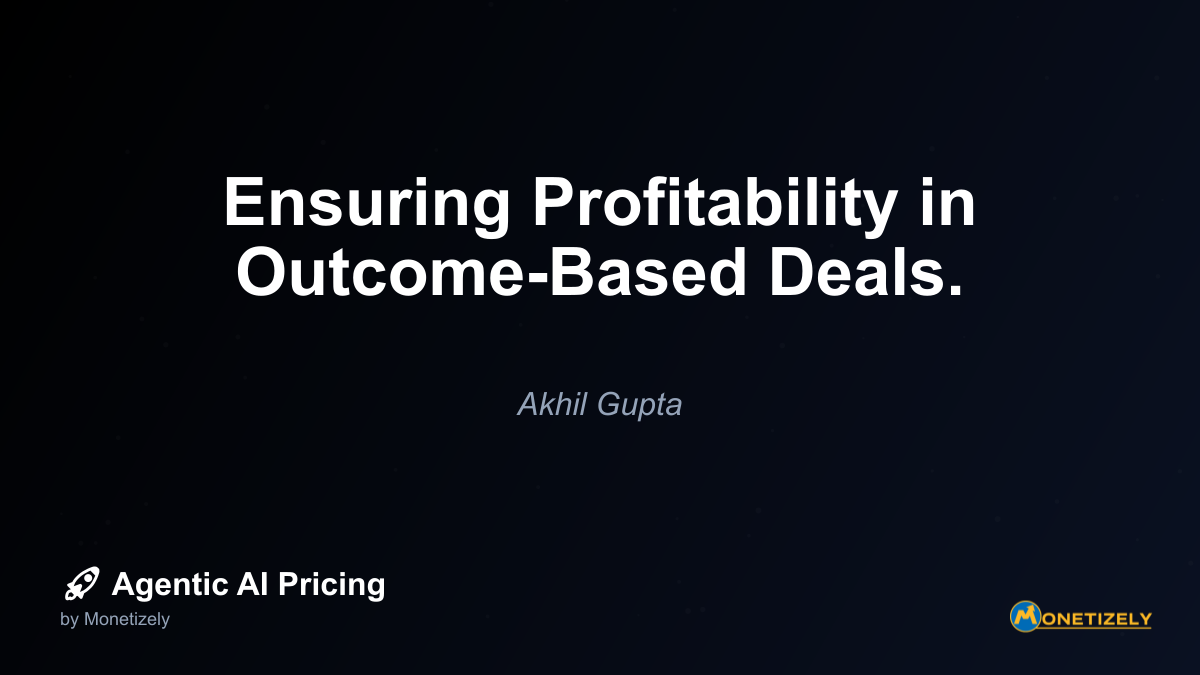· Akhil Gupta · Agentic AI Pricing Strategies · 12 min read
Output-Based Pricing: Charging for AI Deliverables.
AI and SaaS Pricing Masterclass
Learn the art of strategic pricing directly from industry experts. Our comprehensive course provides frameworks and methodologies for optimizing your pricing strategy in the evolving AI landscape. Earn a professional certification that can be imported directly to your LinkedIn profile.
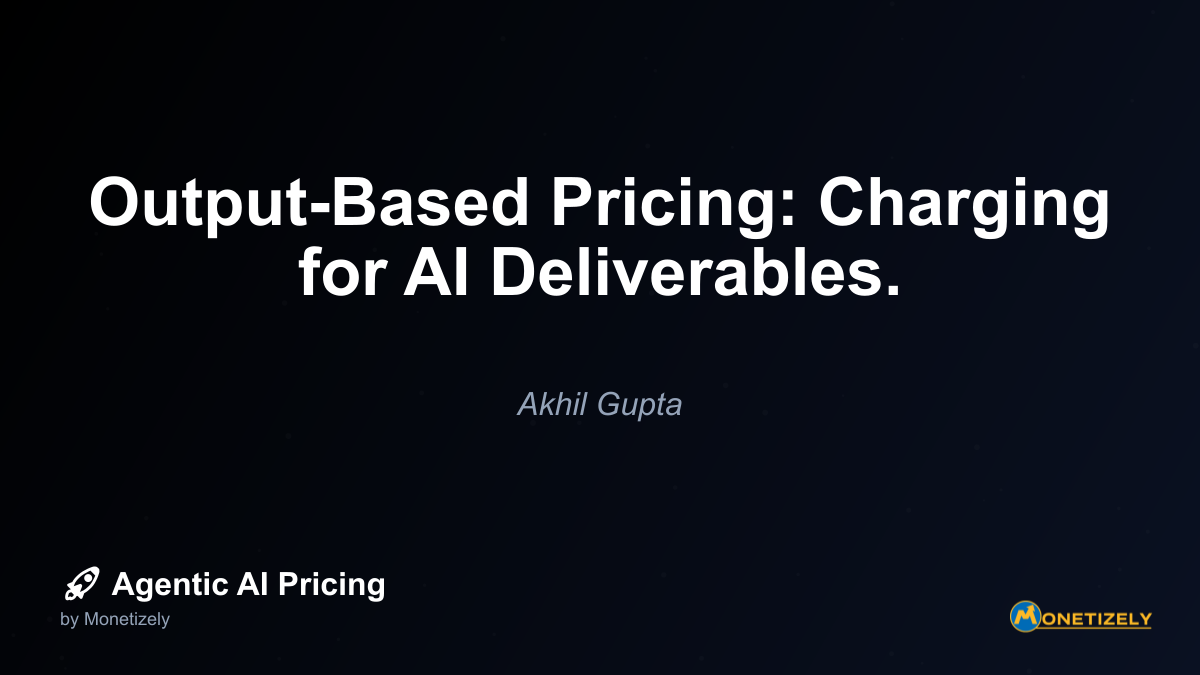
In today’s rapidly evolving AI landscape, businesses are continuously searching for pricing models that align costs with value. Among these approaches, output-based pricing has emerged as a compelling strategy for AI solutions, focusing on charging customers based on tangible deliverables rather than computational resources or time spent. This approach represents a fundamental shift in how AI services are monetized, emphasizing results over activity.
Understanding Output-Based Pricing for AI
Output-based pricing, also known as deliverable-based or outcome-based pricing, is a model where customers pay specifically for what the AI produces—the concrete outputs or deliverables generated by the system. Unlike input-based models that charge for the resources consumed (such as tokens processed or compute time), output-based pricing ties costs directly to measurable results.
This pricing strategy is particularly relevant for agentic AI systems—autonomous AI agents that can perform complex tasks with minimal human intervention. As these systems become more sophisticated, businesses are increasingly interested in pricing models that reflect the actual value delivered.
Core Components of Output-Based Pricing
Output-based pricing typically includes several key components:
- Clearly defined deliverables: Specific, countable outputs like reports generated, tickets resolved, or documents processed
- Quality metrics: Standards that ensure deliverables meet predetermined quality thresholds
- Volume tiers: Pricing structures that account for different volumes of outputs
- Performance guarantees: Commitments regarding accuracy, timeliness, or other quality measures
The fundamental premise is straightforward: customers pay for what they get, not for the underlying processes or resources that produce those results.
The Market Shift Toward Output-Based Pricing
The AI pricing landscape is experiencing a significant transformation. Recent market analysis indicates a growing shift toward output-based and value-driven pricing models, with the global AI market expanding at a compound annual growth rate (CAGR) of 26-37% through 2030.
This shift is driven by several factors:
Falling inference costs: The cost to use existing AI models for inference has decreased dramatically—over 280x from 2022 to 2024—enabling more granular and output-focused pricing schemes.
Value alignment: Businesses increasingly demand pricing that directly correlates with business outcomes and tangible value.
Competitive differentiation: AI providers are using innovative pricing models to stand out in an increasingly crowded marketplace.
Customer preference: End users prefer transparent pricing tied to concrete deliverables rather than abstract technical metrics like tokens or compute resources.
Case Studies: Output-Based Pricing in Action
Several companies have successfully implemented output-based pricing models for their AI solutions. These real-world examples demonstrate the practical application and benefits of this approach.
FlyCode: Revenue Recovery Pricing
FlyCode offers a compelling example with its Revenue Boost-Based Pricing model. The company’s AI system predicts recovery opportunities for failed payments in subscription businesses, optimizes payment retries via dynamic algorithms, and processes alternative payment methods. Customers pay based on measurable revenue recovered, creating a direct alignment between the cost of the AI service and the value it delivers.
This approach has resulted in strong customer trust and satisfaction due to transparent, real-time reporting on revenue recovered. Clients can see exactly how their payments align with the value they receive, creating a win-win relationship.
Intercom’s Fin AI: Matrix-Based Outcome Pricing
Intercom’s Fin AI, which serves financial institutions, employs a hybrid outcome-based pricing model that combines user counts and deployed AI models. This matrix approach allows for fine-grained alignment of costs with delivered value, accommodating different scales of implementation and usage patterns.
The pricing structure balances predictability with value-based charging, enabling customers to scale their AI usage while maintaining a clear connection between costs and outcomes.
Anthropic’s Claude: Output-Weighted Pricing
Anthropic experimented with output-weighted pricing for their Claude assistant, charging customers based on AI-generated responses (output tokens) rather than just input processing. Beta testing showed a 23% increase in customer satisfaction, demonstrating the value of aligning pricing with delivered AI output.
This model encourages users to provide rich, detailed prompts without worrying about input costs, focusing instead on the quality and utility of the AI’s responses.
Advantages of Output-Based Pricing
Output-based pricing offers several significant advantages for both AI providers and their customers:
1. Value Alignment
Perhaps the most compelling benefit is the direct alignment between cost and value. Customers pay for tangible results rather than abstract computational resources, creating a clearer connection between their investment and the benefits they receive.
This alignment extends to incentives as well—AI providers are motivated to deliver high-quality, efficient outputs rather than maximizing resource usage or subscription periods.
2. Customer-Centric Approach
Output-based pricing resonates with customers who care about results rather than the underlying technology. Business leaders can more easily justify AI investments when costs directly correlate with countable deliverables or measurable outcomes.
Research indicates that 76% of customers rate clear pricing as critical in AI vendor selection, and business users prefer simple, outcome-linked pricing aligned with their ROI rather than technical metrics like tokens or prompts.
3. Encourages Effective Usage
Unlike input-based models that can discourage detailed prompting due to cost concerns, output-based pricing encourages users to provide rich, comprehensive inputs to achieve the best possible outputs. This leads to more effective AI utilization and better overall results.
4. Scalability and Flexibility
Output-based pricing can scale naturally with usage and value, allowing customers to start small and expand as they realize benefits. This reduces initial adoption barriers while enabling growth as the AI demonstrates its worth.
5. Competitive Differentiation
For AI providers, output-based pricing can serve as a powerful differentiator in a crowded marketplace, demonstrating confidence in their solution’s ability to deliver measurable value.
Challenges and Considerations
Despite its advantages, output-based pricing isn’t without challenges:
1. Revenue and Cost Unpredictability
For providers, output-based pricing can create revenue uncertainty, as income depends on the volume and nature of outputs requested by customers. Similarly, customers may face unpredictable costs if output volumes fluctuate significantly.
To address this, many providers implement hybrid models that combine base subscriptions with output-based components, balancing predictability with value-based charging.
2. Technical Complexity
Implementing output-based pricing requires sophisticated tracking and measurement systems to accurately count and categorize deliverables. Providers must invest in robust infrastructure to monitor outputs, assess quality, and generate transparent billing information.
3. Output Quality and Definition
Defining what constitutes a “quality” output can be challenging, particularly for complex AI applications. Providers must establish clear quality metrics and standards to prevent disputes and ensure customer satisfaction.
4. Potential for Overemphasis on Quantity
There’s a risk that output-based pricing could incentivize quantity over quality, particularly if pricing is tied solely to output volume without adequate quality controls.
5. Ramp-Up Periods
AI systems often improve over time as they learn from interactions and feedback. Output-based pricing must account for these ramp-up periods when initial results may under-represent the AI’s eventual value.
Industry-Specific Applications
Output-based pricing can be tailored to various industries, each with unique deliverables and value metrics:
Healthcare
In healthcare, AI agents can be priced based on:
- Diagnostic reports generated
- Patient cases reviewed
- Treatment plans formulated
- Medical images analyzed
For example, a radiology AI might charge per scan analyzed, with pricing tiers based on the complexity of the analysis and the comprehensiveness of the report generated.
Finance
Financial services applications include:
- Revenue recovered from failed payments
- Fraudulent transactions detected
- Investment opportunities identified
- Financial reports generated
FlyCode’s model exemplifies this approach, tying pricing directly to recovered revenue in subscription businesses.
Legal
Legal AI applications can implement output-based pricing through:
- Contracts reviewed
- Document summaries produced
- Legal research reports generated
- Compliance issues identified
A legal research AI might charge per comprehensive research report delivered, with pricing reflecting the depth and complexity of the analysis.
Customer Service
Customer service applications are particularly well-suited to output-based pricing:
- Tickets resolved
- Customer queries answered
- Issues escalated appropriately
- Customer satisfaction scores achieved
This model aligns perfectly with the core function of customer service AI: resolving customer issues efficiently and effectively.
Implementing Output-Based Pricing: Best Practices
Successfully implementing output-based pricing requires careful planning and execution:
1. Define Measurable Deliverables
Start by clearly defining what constitutes a countable output or deliverable. These should be:
- Specific and unambiguous
- Easily measurable
- Aligned with customer value
- Quality-controlled
For example, a “resolved ticket” might be defined as a customer inquiry that receives a response and is closed without reopening within 48 hours.
2. Establish Quality Standards
Create clear quality criteria for each type of deliverable to ensure that pricing is tied not just to quantity but also to value. These standards might include:
- Accuracy thresholds
- Completeness requirements
- Timeliness metrics
- Customer satisfaction scores
3. Implement Robust Tracking and Reporting
Develop systems to accurately track and report on deliverables, providing transparency for both the provider and customer. This infrastructure should:
- Count outputs accurately
- Apply quality filters
- Generate detailed reports
- Support real-time monitoring
4. Design Appropriate Pricing Tiers
Create a tiered pricing structure that accommodates different volumes and types of outputs:
- Volume discounts for higher usage
- Premium pricing for higher-quality or more complex outputs
- Bundled pricing for related deliverables
- Minimum commitments to ensure baseline revenue
5. Consider Hybrid Models
For many businesses, a hybrid approach combining output-based pricing with other models may be optimal:
- Base subscription + output overages
- Outcome-based pricing with usage caps
- Tiered subscription levels with different output allowances
- Value-sharing models for high-impact applications
6. Provide Transparency and Control
Give customers visibility into their usage and costs, along with tools to control their expenditure:
- Real-time dashboards
- Usage alerts and notifications
- Output caps or throttling options
- Detailed invoicing and reporting
7. Iterate Based on Feedback and Data
Continuously refine your pricing model based on customer feedback and usage data:
- Analyze which outputs deliver the most value
- Identify pricing inefficiencies or misalignments
- Adjust tiers and rates to optimize both customer value and provider revenue
- Introduce new pricing options for emerging use cases
Pricing Frameworks for Output-Based Models
Several frameworks can guide the development of output-based pricing strategies:
Value Driver Identification Framework
This approach focuses on identifying the specific outputs that drive customer value:
- Identify key value drivers: Determine which outputs correlate most strongly with customer success
- Quantify value impact: Measure the financial or operational impact of each output type
- Align pricing accordingly: Set prices that reflect a fair share of the value created
- Implement tracking: Develop systems to monitor and report on value-driving outputs
Hybrid Token-Output Matrix
This framework combines elements of token-based and output-based pricing:
- Baseline subscription: Establish a foundational fee covering basic access and support
- Token allowances: Include token budgets for inputs within each subscription tier
- Output measurement: Track and charge for specific high-value outputs separately
- Dynamic adjustment: Adjust pricing based on the ratio of inputs to valuable outputs
Predictive Price-Elasticity Modeling
This sophisticated approach uses AI itself to optimize output-based pricing:
- Segment analysis: Identify different customer segments with varying price sensitivity
- Usage pattern modeling: Analyze how different segments utilize AI outputs
- Value perception assessment: Measure how different segments value various outputs
- Dynamic price optimization: Set and adjust prices to maximize both adoption and revenue
Outcome-Based Pricing Ladder
This framework creates a progression of pricing tied to increasingly valuable outcomes:
- Basic outputs: Simple, high-volume deliverables priced at lower rates
- Enhanced outputs: More complex or valuable outputs with premium pricing
- Business outcomes: Pricing tied directly to measurable business impacts
- Strategic value: Top-tier pricing for outputs that deliver strategic competitive advantage
Future Trends in Output-Based Pricing
The landscape of output-based pricing continues to evolve, with several emerging trends shaping its future:
1. Increasing Hybridization
We’re seeing growing adoption of hybrid pricing models that combine elements of subscription, usage-based, and output-based approaches. These sophisticated models seek to balance predictability, fairness, and value capture.
2. AI-Powered Dynamic Pricing
Increasingly, AI itself is being used to optimize pricing strategies, creating dynamic systems that adapt in real-time to usage patterns, customer segments, and market conditions.
3. Enhanced Transparency Tools
As output-based pricing becomes more common, we can expect more sophisticated tools for monitoring, reporting, and analyzing AI outputs and their associated costs.
4. Value-Based Pricing Evolution
Output-based pricing is evolving toward more sophisticated value-based approaches that tie costs not just to countable outputs but to their measurable business impact.
5. Composable AI Applications with Flexible Pricing
The rise of composable AI applications, where customers can tailor agent outputs and capabilities, will drive more flexible pricing models that adapt to the specific configuration and value delivered.
6. Regulatory Considerations
As AI regulation evolves, pricing models will need to adapt to ensure fairness, transparency, and compliance with emerging standards and requirements.
Case Study: Implementing Output-Based Pricing for Customer Service AI
To illustrate the practical application of output-based pricing, let’s examine a hypothetical case study of a customer service AI implementation.
Company Background
XYZ Corporation implements an AI-powered customer service solution to handle support tickets across multiple channels. Previously, they paid a flat monthly subscription for the AI service, regardless of usage or outcomes.
The Challenge
XYZ found that the flat subscription model didn’t align with their actual value received. During low-volume months, they felt they were overpaying, while during peak periods, the AI provider had little incentive to ensure optimal performance.
The Output-Based Solution
Working with their AI provider, XYZ implemented an output-based pricing model with the following components:
Base subscription: A minimal monthly fee covering platform access, updates, and basic support
Per-resolution pricing: Charges based on successfully resolved customer tickets, with “resolution” defined as:
- Customer query fully addressed
- No reopening within 72 hours
- Minimum satisfaction score of 4/5
Tiered volume pricing:
- Tier 1: 1-1,000 resolutions/month at $X per resolution
- Tier 2: 1,001-5,000 resolutions/month at $X-10% per resolution
- Tier 3: 5,000+ resolutions/month at $X-20% per resolution
Quality incentives: Bonus discounts for exceeding satisfaction thresholds
Transparency tools: Real-time dashboard showing resolutions, quality metrics, and projected costs
The Results
After implementing output-based pricing, XYZ experienced:
- Cost alignment: Monthly costs now directly reflected the value received
- Improved performance: The AI provider was incentivized to maximize successful resolutions
- Better resource allocation: XYZ could accurately budget based on projected support volumes
- Enhanced transparency: Clear visibility into the relationship between costs and outcomes
- Stronger partnership: Aligned incentives created a more collaborative vendor relationship
This case study demonstrates how output-based pricing can transform a standard vendor relationship into a value-aligned partnership focused on measurable outcomes.
Ethical Considerations in Output-Based Pricing
As with any pricing model, output-based approaches raise important ethical considerations:
1. Quality vs. Quantity Balance
There’s an inherent risk that output-based pricing could incentivize quantity over quality, potentially leading to a focus on generating more outputs rather than better ones. Robust quality metrics and standards are essential to mitigate this risk.
2. Fairness and Transparency
Output-based pricing must be implemented transparently, with clear definitions and measurements that both provider and customer understand and agree upon. Hidden costs or ambiguous metrics can damage trust and satisfaction.
3. Accessibility and Inclusion
Care must be taken to ensure that output-based pricing doesn’t exclude smaller customers or those with unique needs. Flexible tiers and customization options can help address this concern.
4. Data Privacy and Usage Rights
Output-based models often require detailed tracking and analysis of AI outputs, raising questions about data ownership, privacy, and usage rights that must be clearly addressed in contracts and terms of service.
5. Incentive Alignment
While output-based pricing aims to align incentives, it can sometimes create unintended consequences or perverse incentives. Regular review and adjustment of the pricing model can help identify and address any misalignments.
Comparing Output-Based Pricing to Alternative Models
To fully understand the value proposition of output-based pricing, it’s helpful to compare it with alternative AI pricing models:
| Pricing Model | Description | Advantages | Disadvantages | Best For |
|---|---|---|---|---|
| Output-Based | Charges based on tangible deliverables produced | Direct value alignment, encourages quality outputs, customer-centric | Revenue unpredictability, technical complexity in measurement | Results-focused applications with clearly defined deliverables |
| Subscription | Fixed recurring fee for access to the AI service | Predictable revenue and costs, simple to understand | Misaligned with actual usage or value, potential for |
Co-Founder & COO
Akhil is an Engineering leader with over 16+ years of experience in building, managing and scaling web-scale, high throughput enterprise applications and teams. He has worked with and led technology teams at FabAlley, BuildSupply and Healthians. He is a graduate from Delhi College of Engineering and UC Berkeley certified CTO.
Pricing Strategy Audit
Let our experts analyze your current pricing strategy and identify opportunities for improvement. Our data-driven assessment will help you unlock untapped revenue potential and optimize your AI pricing approach.

